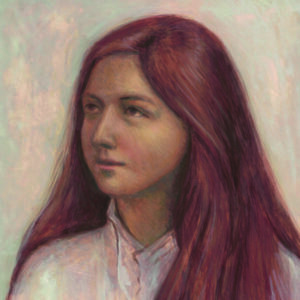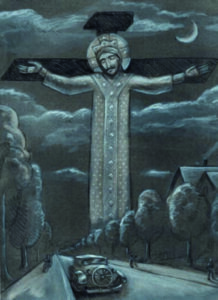“Loving People Back to Life” — Caryll Houselander
Part 2 of 2
When Caryll was 16, her mother abruptly withdrew her from school because she needed her daughter’s help running the boarding house. Returning reluctantly, Caryll found herself working for her mother as a domestic servant. One of her many tasks was shopping for groceries and her second vision occurred while she was shopping for potatoes. At that time in 1918, the major news story was the Russian revolution and the murder of the Czar and the entire royal family. As she made her way to the potato vendor’s stall, she was suddenly stopped in her tracks. In front of her, as if displayed on a large theatre screen, was a “gigantic and living Russian icon.” Vividly, she saw Christ crucified, his head down, his arms reaching to span the world. A few days later, she experienced part two of the same vision at the same corner. She passed a news stand and saw a newspaper picture of the Czar. When she bent down to see the picture more closely, she was startled to see that the face was identical to the face of Christ in her vision. Because of the vision, Caryll began working with Russian refugees and immigrants.
Her third vision came years later and differed considerably from the first two because she saw Christ not in one person such as the German nun or the Russian Czar but in all of humanity. That vision took place while she was riding a crowded London subway. “I was in an underground train, a crowded train in which all sorts of people jostled together, sitting and strap-hanging -- workers of every description going home at the end of the day. Quite suddenly I saw with my mind, but as vividly as a wonderful picture, Christ in them all.”
Combined, these three visions were a source of spiritual enlightenment for Caryll. Through them she realised that in spite of two World Wars, Christians have no enemies; that Christ can be seen in all of humanity. She would spend the rest of her life seeing Christ in every person she met. As a result, ordinary life took on a sacramental dimension. She sought to manifest the presence of Christ in her life while seeking to evoke that same presence out of other lives. Caryll was especially drawn to those marginalised by society, devoting much of her time to them: the mentally ill, traumatised children, immigrants, refugees, the poor.
Caryll’s last few years were filled with illness. Beginning in 1949, she suffered from pneumonia, influenza, tuberculosis, and finally she was diagnosed with cancer. She was very much aware that her time was short. In the summer of 1954, Caryll’s health began to deteriorate even more. She died on 12 October 1954, just a few weeks before her fifty-third birthday. The wonder and lingering impact of Caryll Houselander lies in her eloquent ability to articulate the profound truth that the heart of the Christian faith is love: the love of God and the love of humanity.
Being like Caryll Houselander
1. Respond to people’s hopes as well as their hurts
Caryll received letters from people who were struggling with depression, chronic illness, divorce (which was judged more harshly in her time) and consequent feelings of guilt. She empathised with their dilemmas and always tried to generate hope. In spite of their life’s challenges, she reminded them of God’s love for them and of their own innate worthiness.
2. Don’t be seduced by materialism
Of course, there’s nothing wrong with earning a living or even a very good one. However, don’t make the accumulation of wealth your life goal. Caryll had considerable talent as an artist, poet and writer. Yet, she used her gifts to benefit others rather than just herself.
3. Learn from those less fortunate
One of Caryll’s most memorable experiences occurred while she was volunteering at a mental hospital. As a volunteer, she was there to help others and to be a blessing to the mentally ill. However, she ended up being helped by the patients, and was blessed by her encounter with them. Like Caryll, be willing to learn from others, especially those who occupy a lower place in society.
4. See Christ in every person
In her book, The Comforting of Christ, Caryll reminded readers: “If we are not interested in the minds, the feelings, the hopes, the fears, sorrows and joys of everyone with whom we come in contact, we are not interested in Christ. Whatever we do to anyone, we do to him.”
 5. Help bring out the Christ which dwells within every person
5. Help bring out the Christ which dwells within every person
Caryll viewed Mary as a model of the spiritual life, saying that our task is like that of Mary, namely, to bear Christ into the world. Remember that many people are unaware of the Christ dwelling within them. By both your words and acts, be the one who nurtures and helps give birth to that indwelling Christ.
6. Don’t allow your imperfections prevent you from making a difference
Caryll had many limitations and imperfections. She did not have a strong body and suffered from a variety of chronic conditions all of her life. A chain smoker, she was so shy that some referred to her as a recluse. Even in her own home, she found it difficult to enter a room in which there were other people. At times she would go to the door two or three times before she finally forced herself to go in. At other times, she failed to persuade herself to enter the room. Caryll suffered frequently from panic attacks. In spite of such human imperfections, she cultivated and expressed the talents given to her making a difference to thousands of people. Although far from perfect, Caryll wrote fifteen books and more than seven hundred poems.

7. Be open to sensing the presence of God in the ordinary
Caryll had three visions. Interestingly, those experiences of God’s presence took place in very ordinary, daily life experiences. She experienced the divine presence while watching a woman clean shoes, while grocery shopping for potatoes and while glancing at a newspaper at a news vendor’s stand.
8. Enjoy your life
Observing her mother, Caryll realised that her mother’s life was filled with too much duty and obligation and not enough leisure and pleasure. Caryll made up her mind to work hard but also to enjoy living. Look at how you live and ask yourself , “Is my life all work and responsibility?” If so, take steps which will bring more beauty and pleasure, spontaneity and play into your life.
9. Heighten your sensory awareness
Much of Caryll’s writing shows she drew inspiration from all of her senses. In her writings she refers to tree bark, delicate blades of grass, the sun’s warmth, the sounds of the sea, blight on a green leaf, smells of laundered linens, lemon oil and soap. Recapture the ability to truly see, hear, feel, taste and smell. Be thankful to God for your senses.
 10. Reach out to people marginalised by society
10. Reach out to people marginalised by society
Throughout her life, Caryll responded to suffering people wherever she found them. She worked with Russian immigrants, refugees, traumatised children, the mentally ill, the poor. When you see a hurt, try to be a healer. Reach out to people who are marginalised by society. Give some of your time to those who can benefit from your wisdom, your experience, your compassionate presence.


 Entries(RSS)
Entries(RSS)